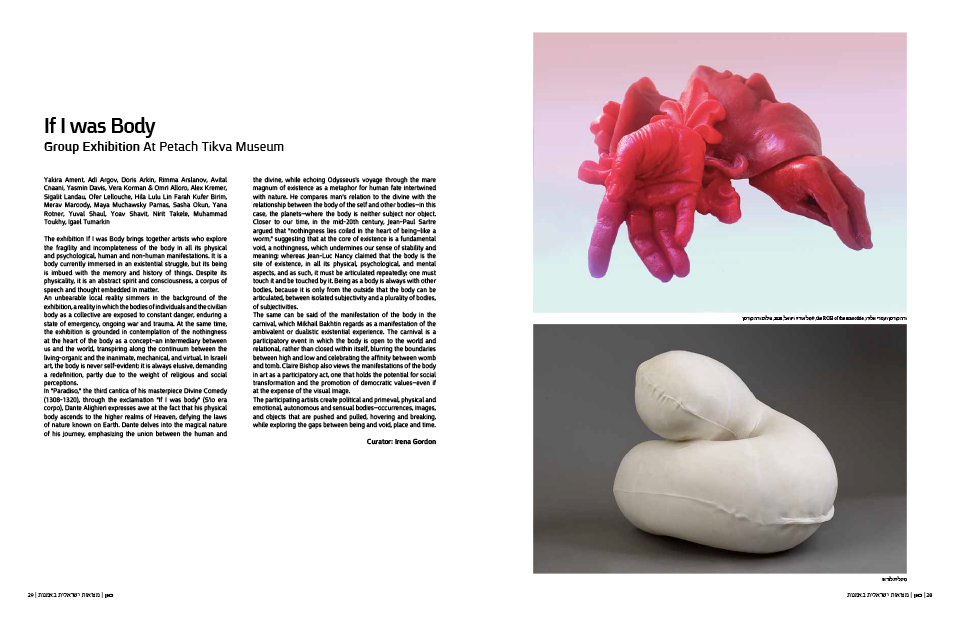
| Home Page | Editor Notices | Museums | Galleries | Publication | Donation | Contact Us |


 | |||||||||||||||
| |||||||||||||||


| |||||||||||||||
| Group Exhibition At Petach Tikva Museum |
Yakira Ament, Adi Argov, Doris Arkin, Rimma Arslanov, Avital Cnaani, Yasmin Davis, Vera Korman & Omri Alloro, Alex Kremer, Sigalit Landau, Ofer Lellouche, Hila Lulu Lin Farah Kufer Birim, Merav Maroody, Maya Muchawsky Parnas, Sasha Okun, Yana Rotner, Yuval Shaul, Yoav Shavit, Nirit Takele, Muhammad Toukhy, Igael Tumarkin The exhibition If I was Body brings together artists who explore the fragility and incompleteness of the body in all its physical and psychological, human and non-human manifestations. It is a body currently immersed in an existential struggle, but its being is imbued with the memory and history of things. Despite its physicality, it is an abstract spirit and consciousness, a corpus of speech and thought embedded in matter. An unbearable local reality simmers in the background of the exhibition, a reality in which the bodies of individuals and the civilian body as a collective are exposed to constant danger, enduring a state of emergency, ongoing war and trauma. At the same time, the exhibition is grounded in contemplation of the nothingness at the heart of the body as a concept—an intermediary between us and the world, transpiring along the continuum between the living-organic and the inanimate, mechanical, and virtual. In Israeli art, the body is never self-evident; it is always elusive, demanding a redefinition, partly due to the weight of religious and social perceptions. In "Paradiso," the third cantica of his masterpiece Divine Comedy (1308-1320), through the exclamation "If I was body" (S'io era corpo), Dante Alighieri expresses awe at the fact that his physical body ascends to the higher realms of Heaven, defying the laws of nature known on Earth. Dante delves into the magical nature of his journey, emphasizing the union between the human and the divine, while echoing Odysseus's voyage through the mare magnum of existence as a metaphor for human fate intertwined with nature. He compares man's relation to the divine with the relationship between the body of the self and other bodies—in this case, the planets—where the body is neither subject nor object. Closer to our time, in the mid-20th century, Jean-Paul Sartre argued that "nothingness lies coiled in the heart of being—like a worm," suggesting that at the core of existence is a fundamental void, a nothingness, which undermines our sense of stability and meaning; whereas Jean-Luc Nancy claimed that the body is the site of existence, in all its physical, psychological, and mental aspects, and as such, it must be articulated repeatedly; one must touch it and be touched by it. Being as a body is always with other bodies, because it is only from the outside that the body can be articulated, between isolated subjectivity and a plurality of bodies, of subjectivities. The same can be said of the manifestation of the body in the carnival, which Mikhail Bakhtin regards as a manifestation of the ambivalent or dualistic existential experience. The carnival is a participatory event in which the body is open to the world and relational, rather than closed within itself, blurring the boundaries between high and low and celebrating the affinity between womb and tomb. Claire Bishop also views the manifestations of the body in art as a participatory act, one that holds the potential for social transformation and the promotion of democratic values—even if at the expense of the visual image. The participating artists create political and primeval, physical and emotional, autonomous and sensual bodies—occurrences, images, and objects that are pushed and pulled, hovering and breaking, while exploring the gaps between being and void, place and time. Curator: Irena Gordon Read more  |
| all rights reserved - CAN ISRAELI ART REALITY |
| סייבורג מחשבים - בניית אתרים |